(I) To construct the bisector of a given angle
Given: An ∠ABC.
Required: To construct it bisector.
Steps of Construction:
(i) Taking B as centre and any radius, draw an arc to intersect the rays BA and BC, say at E and D, respectively.
(ii) Next, taking D and E as centres and with the radius more than 12 DE, draw arcs to intersect each other, say at F.
(iii) Draw the ray BF. This ray BF is the required bisector of the ∠ABC.
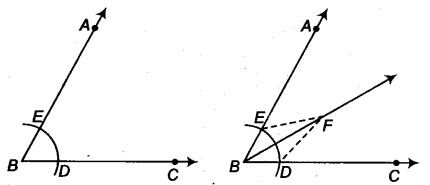
Proof: Join DF and EF.
In ΔBEF and ΔBDF,
BE = BD (Radii of the same arc)
EF = DF (Arcs of radii)
BF = BF (Common)
Therefore, ΔBEF = ΔBDF (SSS rule)
This gives ∠EBF = ∠DBF (CPCT)
(II) To construct the perpendicular bisector of a given line segment
Given: A line segment AB.
Required: To construct its perpendicular bisector.
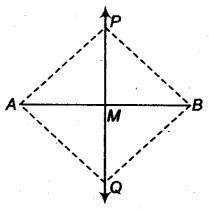
Steps of Construction:
(i) Taking A and B as centres and radius more than 12 AB, draw arcs on both sides of the line segment AB (to intersect each other).
(ii) Let these arcs intersect each other at P and Q. Join PQ.
(iii) Let PQ intersect AB at the point M. Then, line PMQ is the required perpendicular bisector of AB.
Proof: Join A and B to both P and Q to form AP, AQ, BP and BQ.
In ΔPAQ and ΔPBQ,
AP = BP (Arcs of equal radii)
AQ = BQ (Arcs of equal radii)
PQ = PQ (Common)
Therefore, ΔPAQ = ΔPBQ (SSS rule)
So, ∠APM = ∠BPM (CPCT)
Now, in ΔPMA and ΔPMB,
AP = BP (As before)
PM = PM (Common)
∠APM = ∠BPM (Proved above)
Therefore, ΔPMA = ΔPMB (SAS rule)
So, AM = BM and ∠PMA = ∠PMB
As ∠PMA + ∠PMB = 180° (Linear pair axiom)
We get, ∠PMA = ∠PMB = 90°
Therefore, PM, i.e., PMQ is the perpendicular bisector of AB.
(III) Constructs an angle of 60° at the initial point of a given ray
Given: A ray AB with initial point A.
Required: To construct a ray AC such that ∠CAB = 60°.
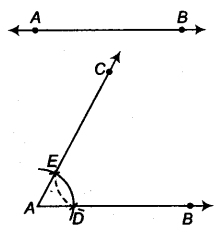
Steps of Construction:
(i) Taking A as the centre and some radius, draw an arc of a circle which intersects AB, say at a point D.
(ii) Taking D as the centre and with the same radius as before, draw an arc intersecting the previously drawn arc, say at a point E.
(iii) Draw the ray AC passing through E. Then ∠CAB required the angle of 60°.
Proof: Join DE.
Then, AB = AD = DE (By construction)
Therefore, ΔEAD is an equilateral triangle and the ∠EAD which is the same as ∠CAB is equal to 60°.
4. Rules of Congruency of Two Triangles
- SAS Two triangles are congruent if any two sides and the included angle of one triangle are equal to any two sides and the included angle of the other triangle.
- SSS Two triangles are congruent if the three sides of one triangle are equal to the three sides of the other triangle.
- ASA Two triangles are congruent if any two angles and the included side of one triangle are equal to the two angles and the included side of the other triangle.
- RHS Two right triangles are congruent if the hypotenuse and a side of one triangle are respectively equal to the hypotenuse and a side of the other triangle.
5. The uniqueness of a Triangle
A triangle is unique, if
- two sides and the included angle is given,
- three sides are given,
- two angles and the included side is given and
- in a right triangle, hypotenuse and one side are given.
6. Requirement for the Construction of a Triangle: For constructing a triangle, at least three parts of a triangle have to be given hut, not all combinations of three parts and sufficient for the purpose, e.g., if two sides and an angle (not the included angle) are given, then it is not always possible to construct such a triangle uniquely.
7. Some Constructions of Triangles
(I) To construct a triangle, given its base, a base angle and sum of other two sides
Given: The base BC, a base angle, say ∠B and the sum AB + AC of the other two sides of a ΔABC.
Required: To construct the ΔABC.
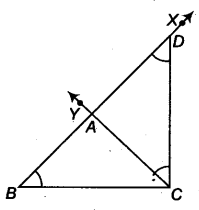
Steps of Construction:
(i) Draw the base BC and at the point B make an angle, say XBC equal to the given angle.
(ii) Cut a line segment BD equal to AB + AC from the ray BX.
(iii) Join DC and make an angle DCY equal to ∠BDC.
(iv) Let CY intersect BX at A (see figure).
Justification
Base BC and CB are drawn as given.
Next in ΔACD,
∠ACD = ∠ADC (By construction)
AC = AD (Sides opposite to equal angles of a triangle are equal)
AB = BD – AD = BD – AC
⇒ AB + AC = BD
Alternative Method
(i) Draw the base BC and at the point B make an angle, say XBC equal to the given angle.
(ii) Cut a line segment BD equal to AP + AC from the ray BX.
(iii) Join DC.
(iv) Draw perpendicular bisector PQ of CD to intersect BD at a point A.
(v) Join AC.
Then, ABC is the required triangle.

Justification
Base BC and CB are drawn as given.
A lies on the perpendicular bisector of CD.
AD = AC
AB = BD – AD = BD – AC
AB + AC = BD
Remark: The construction of the triangle is not possible if the sum AB + AC < BC.
(II) To construct a triangle given its base, a base angle and the difference of the other two sides
Given: The base BC, a base angle, say CB and the difference of other two sides AB – AC or AC – AB.
Required: To construct the ΔABC.
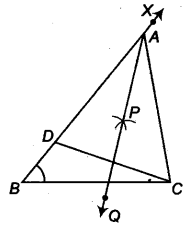
There are the following two cases
Case (I): Let AB > AC, i.e., AB – AC is given.
Steps of Construction:
(i) Draw the base BC and at point B make an angle, say XBC equal to the given angle.
(ii) Cut the line segment BD equal to AB – AC from ray BX.
(iii) Join DC and draw the perpendicular bisector, say PQ of DC.
(iv) Let it intersect BX at a point A. Join AC.
Then, ABC is the required triangle.
Justification
Base BC and ∠B are drawn as given.
The point A lies on the perpendicular bisector of DC.
AD = AC
So, BD = AB – AD = AB – AC
Case (II): Let AB < AC i.e., AC – AB is given.
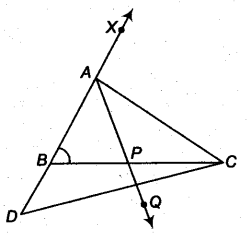
Steps of Construction:
(i) Draw the base BC and at point B make an angle, say XBC equal to the given angle.
(ii) Cutline segment BD equal to AC – AB from the line BX extended on an opposite side of line segment BC.
(iii) Join DC and draw the perpendicular bisector, say PQ of DC.
(iv) Let PQ intersect BX at A. Join AC.
Then, ABC is the required triangle.
Justification
Base BC and CB are drawn as given.
The point A lies on the perpendicular bisector of DC.
AD = AC
So, BD = AD – AB = AC – AB
(III) To construct a triangle, given its perimeter and its two base angles
Given: The base angles, say ∠B and ∠C and BC + CA + AB.
Required: To construct the ΔABC.
Steps of Construction:
(i) Draw a line segment, say XY equal to BC + CA + AB.
(ii) Make angles LXY equal to ∠B and MYX equal to ∠C.
(iii) Bisect ∠LXY and ∠MYX. Let these bisectors intersect a point A.
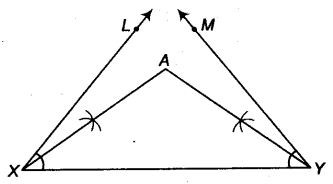
(iv) Draw perpendicular bisectors PQ of AX and RS of AY.
(v) Let PQ intersect XY at B and RS intersect XY at C. Join AB and AC.

Then, ABC is the required triangle.
Justification
B lies on the perpendicular bisector PQ of AX.
∴ XB = AB
C lies on the perpendicular bisector RS of AY.
∴ CY = AC
This gives
BC + CA + AB = BC + XB + CY = XY
Again, ∠BAX + ∠AXB (in ΔAXB, AB = XB)
and ∠ABC = ∠BAX + ∠AXB = 2∠AXB = ∠LXY
Next, ∠CAY = ∠AYC (in ΔAYC, AC = CY)
and ∠ACB = ∠CAY + ∠AYC = 2∠AYC = ∠MYX
Thus, we have what is required.


